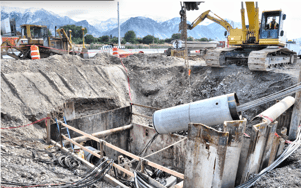INVESTMENT
Concrete Pipe: Enduring Investment.
 Concrete pipe’s rigid structure dual purposes as both a sturdy frame and hydraulic conduit. This design provides ease of installation and reliability, with over 85% of its strength being self-contained. Such significant self-reliance ensures lower-risk installation, reducing dependency on installers for the pipe's performance, subsequently diminishing risk and long-term costs for stakeholders. Its inherent rigidity, modular segments, limited compaction requirements, and minimal reliance on soil compaction all contribute to accelerating the installation process and enhancing efficiency. These attributes not only facilitate immediate cost reductions but also promise long-term financial savings, underscoring concrete pipe as a wise, cost-effective investment for projects demanding trusted, efficient installation.
Concrete pipe’s rigid structure dual purposes as both a sturdy frame and hydraulic conduit. This design provides ease of installation and reliability, with over 85% of its strength being self-contained. Such significant self-reliance ensures lower-risk installation, reducing dependency on installers for the pipe's performance, subsequently diminishing risk and long-term costs for stakeholders. Its inherent rigidity, modular segments, limited compaction requirements, and minimal reliance on soil compaction all contribute to accelerating the installation process and enhancing efficiency. These attributes not only facilitate immediate cost reductions but also promise long-term financial savings, underscoring concrete pipe as a wise, cost-effective investment for projects demanding trusted, efficient installation.
A common misuse of the concept of least cost is the adoption of that analysis when choosing underground drainage pipe material. Least cost variables, including material cost, material life, inflation rates, replacement cost and residual values are vital in the design of roadway pavements. These same criteria, however, just don’t work when attempting to predict the service life for pavements and underground utilities working together as a system. The underground material service life must, in all cases, exceed the design life of the entire roadway system. It would be inconceivable to replace a concrete roadway surface one year and reach the material service life of an underground culvert the next, necessitating an early re-replacement of the road.
For this reason, Life Design should be used to evaluate all underground drainage culverts and storm sewers. The Life Design concept encompasses all factors that could potentially lead to the premature repair or replacement of a roadway surface. Basically, materials are chosen for use based on their ability to remain in service for, at a minimum, of the design life of the roadway system.
Life Design takes into consideration material service life, defined as the long term structural strength of either the pipe itself or of the soil/pipe interaction system insuring that required design strength will not decline during the life of the system. Additionally, the pipe itself must maintain its hydraulic capacity, not experiencing losses due to changes in the pipe wall (rippling) or as a result of deflection.
The ability of a pipe material to survive unanticipated external events including fires, flashovers and flooding is also a major design element of Life Design. Finally, protecting the environment by insuring that pipe materials do not leach toxic substances into our nations estuaries will help maintain our fragile natural resources.
The Life Design “costs” of a system are inclusive of all of the elements of Life Design and provide for a more accurate gauge of the fully absorbed cost of the asset. Initial material cost, design costs, soil testing (in the case of flexible materials), installation costs and post installation costs are all evaluated using the Life Design parameters as a minimum. Repair and maintenance costs should be minimal at best and replacement during the life of the system should not be an option.
Concrete pipe will easily meet all of the demands of Life Design as it remains the strongest, most hydraulically efficient, durable and environmentally friendly pipe available today.
Structure & Conduit
Plant tested to carry the design load before delivery, the concrete pipe arrives on the job site as the primary structure. With over 85% of the load carried by the pipe itself and stabilized by the surrounding soil, the robustness of the structure ensures the conduit is provided.
Lower-Risk
With so little of the strength of the system being dependent on the installation, there is a significant decrease on the reliance of the installation and installers to ensure the performance of the pipe, reducing the risk and long-term costs for the designer, specifier, and owner.
Efficient
Concrete pipe’s strength, its modular nature, and compaction allows installers to move faster and more efficiently when installing the product.
Lower Cost
With lower risk, less dependance on imported backfill, and increased efficiencies, the installation of concrete pipe can result in a lower cost of the project in both the short and long term.


